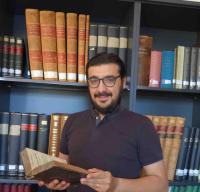Further to our visit to the Biblioteca Apostolica Vaticana in June and as announced in the first blog entry in July, here follow some on-site autopsy results of a few manuscripts I had the opportunity to consult during the visit. The information pertaining to the first manuscript described below can be found as Metadata in the Göttingen Virtual Manuscript Room. The information pertaining to the other manuscripts can be considered as draft entries of a catalogue of Coptic liturgical manuscripts, which is under construction.
sa 349L, 14–15th century[1]
Biblioteca Apostolica Vaticana, Borg. Copt. 109, cass. XXIII, fasc. 98
Four extant folios originally belonging to a bilingual Sahidic–Arabic Holy Week lectionary of which another two folios are preserved at the Bibliothèque nationale de France. Written on unwatermarked Egyptian glossy ‘two-layered’ paper,[2] with apparent laid lines and non-distinguishable chain marks. Page dimensions 36.5x22.5 cm, text coverage 31x19 cm, lines per page 25 for the Sahidic text and 25 for the Arabic text, line width 11–13 cm for the Sahidic text and ca. 5 cm for the Arabic text, intercolumn ca.1 cm. 10 lines of text: 12 cm. Ornamented hanging capital letters in black, red, yellow, and green up to 7 cm in height at the beginning of pericopes. Hanging capital letters in black, red, and yellow at the beginning of paragraphs. The last two extant folios, which preserve the readings for the Synaxis on Holy Thursday with a pericope from the book of Isaiah, namely Isaiah 32,1–16, are the only known example with this reading at that hour, whereas all other Holy Week lectionaries I have examined have another Isaiah reading at that same hour, usually from Isaiah 52–53.
Borg.copt.52, 18th century[3]
Bilingual Bohairic–Arabic Holy Week lectionary written on European paper with the tre lune watermark (in transmitted light, the paper reveals the distinctive originally Italian watermark tre lune,[4] (see fig. 1 below) three moon crescents in decreasing size, specifically created for the Levant),[5] 460 folios. Page dimensions 315x215 mm, written text dimensions 240x155 mm, lines per page 22–23, 10 lines height 10 cm, line width 10–11 cm for the Bohairic text, 4–4.5 cm for the Arabic text, intercolumn ca. 1 cm. The Bohairic columns end with catchwords. All alphas (ⲁ) at the beginning of a pericope are ornamented as birds, some surmounted by a cross (more than 70 occurrences). Begins with Palm Sunday Eve and ends with the Synaxis on Easter Sunday, includes the whole text of the Apocalypse. Colophon on folio 459v dated 2 of Tout 1492 A.M., 1189 A.H., corresponding to 1775 A.D. Scribe Dāwūd Mīnā Aljīzāwī (داوود مينا الجيزاوي), surnamed al-Muwaqaʿ (الموقع), deacon of the Coptic Catholic Church.

Fig. 1: Three crescents, watermark in Isl. Ms. 589 (Yemen 1660)[6]
Vat.copt.34, 16th–17th century[7]
Bohairic manuscript with Bohairic–Arabic rubrics, 299 folios, page dimensions 295x205 mm, 21 lines per page. Begins with Palm Sunday and ends with Easter Sunday. This manuscript was written by two different hands. The first hand wrote the first 90 pages (up unto folio 45v, line 7) and the second hand undertook the writing from folio 45v, line 8 up unto the end of the manuscript. Anonymous invocations to pray for the soul of the ‘unworthy scribe’ are written in Arabic at the bottom of the page on folios 21v, 62r, 66v, 158v and 219r.[8]
Vat.copt.90, 18th century[9]
Bohairic manuscript with Bohairic–Arabic rubrics, 298 folios, page dimensions 330x225 mm, 22–25 lines per page. Begins with Palm Sunday and ends with Easter Sunday. Arabic colophon on f. 297 written by the scribe Maqarios ibn ishm Allah, monk at the Baramous Monastery in the Nitrian Desert and dated 1440 A.M., 1724 A.D.
Vat.ar.15, 14th century
We wrongly assumed that this non-digitized Arabic codex was a Holy Week lectionary. It turned out to be a Gospel lectionary with an index of all the lections from the New Testament to be read during the prayers and the masses all days of the year.[10] The 138 folios are made of unwatermarked Egyptian paper. This Gospel lectionary features a colophon on folio 135, dated 1054 A.M., 1338 A.D.
Bibliography
- Atanassova, Diliana (2018). Neue Erkenntnisse bei der Erforschung der sahidischen Quellen für die Paschawoche, in: Heike Behlmer, Ute Pietruschka and Frank Feder (eds), Ägypten und der Christliche Orient. Peter Nagel zum 80. Geburtstag (Texte und Studien zur Koptischen Bibel 1). Wiesbaden: Harrassowitz, 1–37.
- Briquet, Charles-Moise (1907). Les filigranes. Dictionnaire historique des marques du papier dès leur apparition vers 1282 jusqu’en 1600 avec 39 figures dans le texte et 16 112 fac-similés de filigranes, volume 2 (Ci-K), Paris : Alphonse Picard et Fils.
- Burmester, Oswald Hugh Edward (1933). Le Lectionnaire de la Semaine Sainte. Texte copte édité avec traduction française d’après le manuscrit Add. 5997 du British Museum, vol. I (Patrologia Orientalis, 24,2, Nr. 117). Paris: Firmin-Didot (Reprint Turnhout: Brepols 1985).
- Hebbelynck, Adolph/van Lantschoot Arnold (1937). Codices Coptici Vaticani Barberiniani Borgiani Rossiani, I: Codices Coptici Vaticani, Bibliothecae Apostolicae Vaticanae codices manu scripti recensiti. Rome: In Bibliotheca Vaticana.
- Humbert, Geneviève (2002), Le manuscrit arabe et ses papiers, in Revue des mondes musulmans et de la Méditerranée 99–100/2002, 55–77, 67. https://journals.openedition.org/remmm/1174.
- Kropf, Evyn. Watermark Wednesdays blog series. Beyond the Reading Room (2014–2016).
https://blogs.lib.umich.edu/beyond-reading-room/watermark-wednesdays-three-crescents.
- Le Léannec-Bavavéas, Marie-Thérèse (1998). Les papiers non filigranés. État présent des recherches et perspectives d'avenir. Paris: CNRS Éditions.
- Karabacek, Joseph von, (1991). Joseph von Karabacek, Arab Paper 1887, translated by Don Baker and Suzy Dittmar with additional notes by Don Baker. London: Archetype Publications.
- Mai, Angelo (1831). Catalogus codicum bibliothecae Vaticanae Arabicorum, Persicorum, Turcicorum, Chaldaicorum, Aethiopicorum, Slavicorum, Indicorum, Copticorum, Armenicorum et Ibericorum, item ejus partis Hebraicorum et Syriacorum, quam Assernanni in editione praeternisserunt Catalogus Codicum Bibliothecae Vaticanae. Rome: Typis
Vaticanis.
- Zanetti, Ugo (1986). Filigranes vénitiens en Égypte, in Studi Albanologici, Balcanici, Bizantini e Orientali, in onore di Giuseppe Valentini S.J., (= Studi albanologici. Studi e Testi, 6). Florence: Olschki, 437–499.
[1] First identified by Atanassova as belonging to a Holy Week lectionary, Cf. Atanassova, Neue Erkenntnisse,12–13.
[2] Karabacek, Arab Paper, 29–30; Zanetti, Filigranes vénitiens, 445–446; Le Léannec-Bavavéas, Les papiers non
filigranés, 85–86.
[3] Included as R3 in Burmester’s collation of 21 manuscripts, cf. Burmester, Lectionnaire, I, 176.
[4] Briquet, Les filigranes, 314b–315a; Zanetti, Filigranes vénitiens, 447–448.
[5] Humbert, Le manuscrit arabe, 67. https://journals.openedition.org/remmm/1174.
[6] From Evyn Kropf, Watermark Wednesdays: Three crescents, https://blogs.lib.umich.edu/beyond-reading-
room/watermark-wednesdays-three-crescents
[7] Included as R in Burmester’s collation of 21 manuscripts, cf. Burmester, Lectionnaire, I, 176.
[8] For more details on the contents, cf. Hebbelynck/van Lantschoot, Codices Coptici Vaticani, 126–135.
[9] Included as R1 in Burmester’s collation of 21 manuscripts, cf. Burmester, Lectionnaire, I, 176.
[10] Mai, Catalogus, Codices Arabici, 14–34.
 Blogs
Blogs  最近参加したブロガー
最近参加したブロガー 




